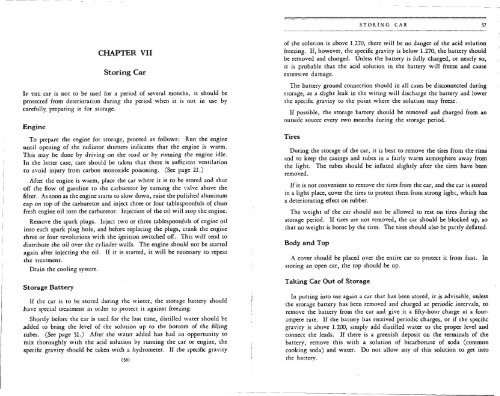1928 Cadillac - GM Heritage Center
1928 Cadillac - GM Heritage Center
1928 Cadillac - GM Heritage Center
You also want an ePaper? Increase the reach of your titles
YUMPU automatically turns print PDFs into web optimized ePapers that Google loves.
STORING CAR 57<br />
CHAPTER VII<br />
Storing Car<br />
IF THE car is not to be used for a period of several months, it should be<br />
protected from deterioration during the period when it is not in use by<br />
carefully, preparing it for storage.<br />
Engine<br />
To prepare the engine for storage, proceed as follows: Run the engine<br />
until opening of the radiator shutters indicates that the engine is warm.<br />
This may be done by driving on the road or by running the engine idle.<br />
In the latter case, care should be taken that there is sufficient ventilation<br />
to avoid injury from carbon monoxide poisoning. (See page 21.)<br />
After the engine is warm, place the car where it is to be stored and shut<br />
off the flow of gasoline to the carburetor by turning the valve above the<br />
filter. As soon as the engine starts to slow down, raise the polished aluminum<br />
cap on top of the carburetor and inject three or four tablespoonfuls of clean<br />
fresh engine oil into the carburetor. Injection of the oil will stop the engine.<br />
Remove the spark plugs. Inject two or three tablespoonfuls of engine oil<br />
into each spark plug hole, and before replacing the plugs, crank the engine<br />
three or four revolutions with the ignition switched off. This will tend to<br />
distribute the oil over the cylinder walls. The engine should not be started<br />
again after injecting the oil. If it is started, it will be necessary to repeat<br />
the treatment.<br />
Drain the cooling system.<br />
Storage Battery<br />
If the car is to be stored during the winter, the storage battery should<br />
have special treatment in order to protect it against freezing.<br />
Shortly before the car is used for the last time, distilled water should be<br />
added to bring the level of the solution up to the bottom of the filling<br />
tubes. (See page 51.) After the water added has had an opportunity to<br />
mix thoroughly with the acid solution by running the car or engine, the<br />
specific gravity should be taken with a hydrometer. If the specific gravity<br />
(56)<br />
of the solution is above 1.270, there will be no danger of the acid solution<br />
freezing. If, however, the specific gravity is below 1.270, the battery should<br />
be removed and charged. Unless the battery is fully charged, or nearly so,<br />
it is probable that the acid solution in the battery will freeze and cause<br />
extensive damage.<br />
The battery ground connection should in all cases be disconnected during<br />
storage, as a slight leak in the wiring will discharge the battery and lower<br />
the specific gravity to the point where the solution may freeze.<br />
If possible, the storage battery should be removed and charged from an<br />
outside source every two months during the storage period.<br />
Tires<br />
During the storage of the car, it is best to remove the tires from the rims<br />
and to keep the casings and tubes in a fairly warm atmosphere away from<br />
the light. The tubes should be inflated slightly after the tires have been<br />
removed.<br />
If it is not convenient to remove the tires from the car, and the car is stored<br />
in a light place, cover the tires to protect them from strong light, which has<br />
a deteriorating effect on rubber.<br />
The weight of the car should not be allowed to rest on tires during the<br />
storage period. If tires are not removed, the car should be blocked up, so<br />
that no weight is borne by the tires. The tires should also be partly deflated.<br />
Body and Top<br />
A cover should be placed over the entire car to protect it from dust. In<br />
storing an open car, the top should be up.<br />
Taking Car Out of Storage<br />
In putting into use again a car that has been stored, it is advisable, unless<br />
the storage battery has been removed and charged at periodic intervals, to<br />
remove the battery from the car and give it a fifty-hour charge at a fourampere<br />
rate. If the battery has received periodic charges, or if the specific<br />
gravity is above 1.200, simply add distilled water to the proper level and<br />
connect the leads. If there is a greenish deposit on the terminals of the<br />
battery, remove this with a solution of bicarbonate of soda (common<br />
cooking soda) and water. Do not allow any of this solution to get into<br />
the battery.
















